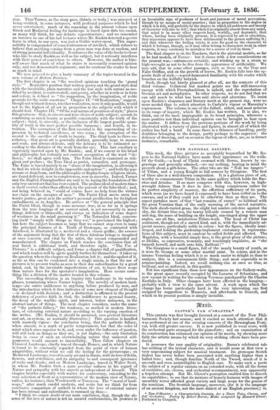TRII NATIONAL GALLERY.
This week, the three pictures so acceptably bequeathed by Mr. Ro- gers to the National Gallery have made their appearance on the walls. Of the Guido,—a head of Christ crowned with thorns known by en- gravings and generally admired,—we say nothing, "Nell in mind the proverb about a gift-horse. The other two are the me tangere " of Titian and a young Knight in full armour by Giorgione. The first of these Ids° is a well-known composition. It is a glorious piece of art, worthy to commemorate Titian in the same gallery which holds the Bac- chus and Ariadne. It no more competes with this, however, in high- wrought fulness than it does in size ; being conspicuous rather for its perfect simplicity of mastery, the effortless sufficiency of its parts, which seem (as we have heard it expressed) to have been willed on to the canvass, and as if they could not be otherwise than as they are. The aspect partakes more of that "last remains of sunset" so habitual with the great Venetian than of the early morning of the sacred narrative. The dark shrub-varied grass, the slight but sombre oak-free against the sky, the distant blue sea, the tawny hill-side crossed by a remote Mall and dog, the mass of building on the height, sun-tinged along the upper angles are all fine, =laborious Titian-work. The head of Christ has sentiment, though not of a sacred kind, and is, with the immediately ad- jacent masses, particularly noble in colour : but the figure, ideally semi- draped, and holding the gardening-implement customary in representa- tions of this subject, must in candour be called feeble and affected. The Magdalen, with a beautiful simple face is the great glory of the picture; so lifelike, so expressive, womanly, and touchingly impulsive, as "she tunteth herself, and saith unto him, Rabbom I" The Giorgione is a small figure, full of the manly beauty of youth, as it were St. George or BOMIl other martial saint. In colour, and in the intense Venetian feeling which it is so much easier to delight in than to analyze, this is a consummate little thing; and most especially BO in armour-painting. Indeed, we recall nothing else at once so true, so brilliant, and so unforced, in this quality.
Not less significant than these new appearances on the Gallery-walls, is the great space recently occupied by the Lazarus of Sebastian° and now vacant in waiting for the coming 'Veronese purchased by Sir Charles Eastlake.in Italy. Other changes have been effected in the hanging— probably with a view to the same advent. A work upon which the change has borne particularly hard is the very interesting one first assigned by suggestion to Masaccio, and afterwards to Gozzoli, and which in its present position is simply invisible.










































 Previous page
Previous page